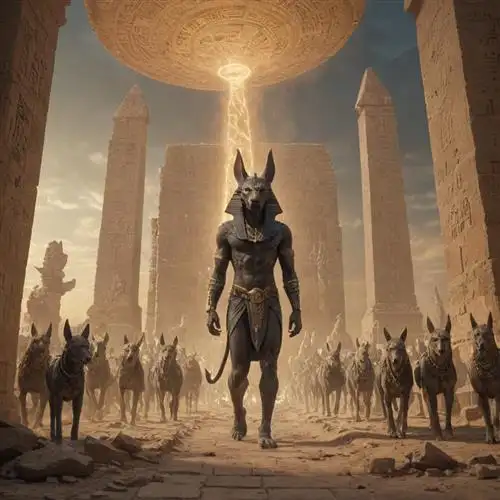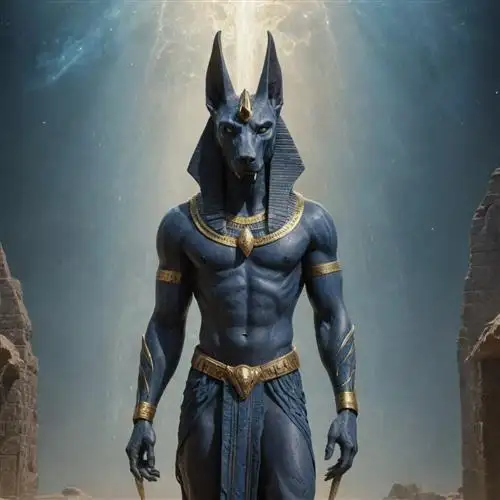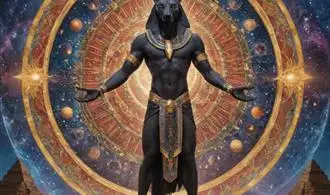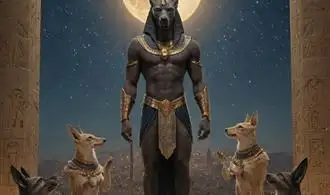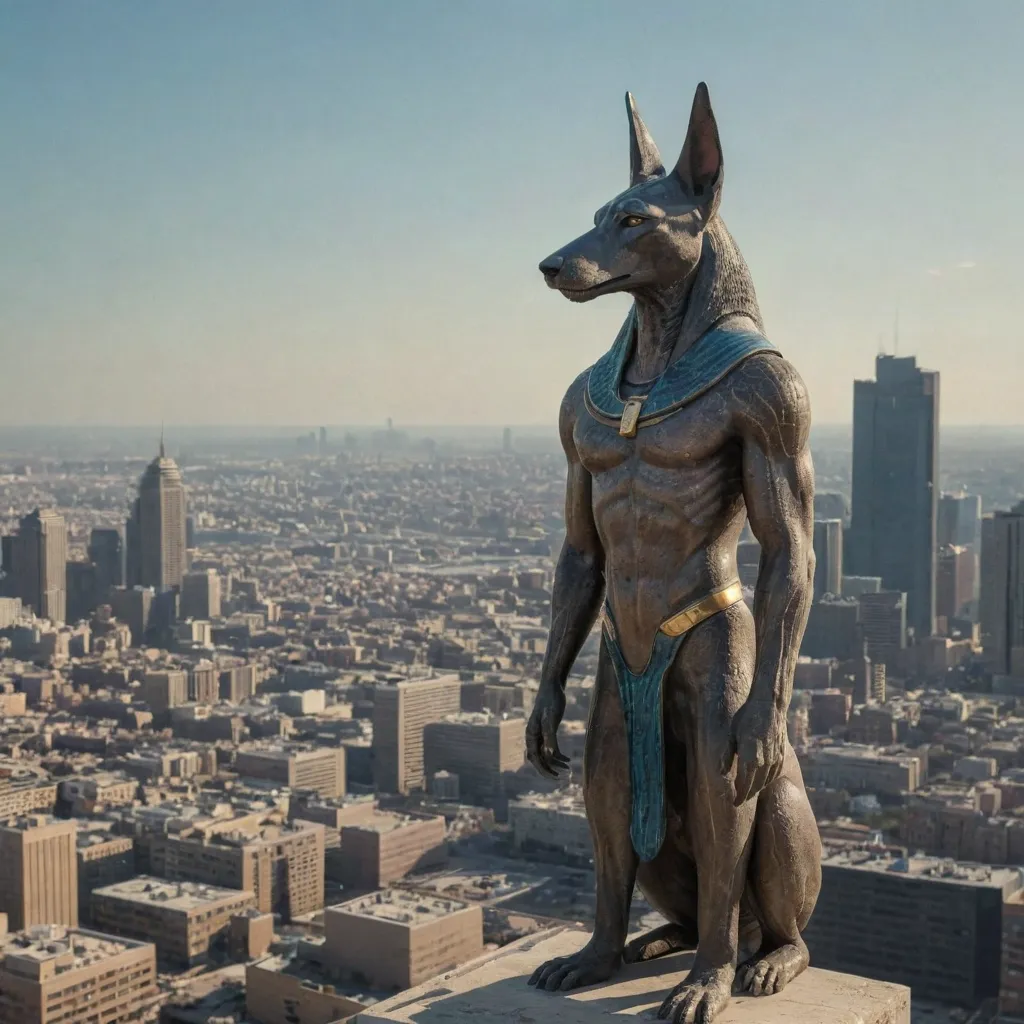
Anubis The Jackal Headed God
Anubis, the enigmatic jackal-headed deity, has long captivated the imagination of scholars and enthusiasts alike. As one of the most prominent figures in ancient Egyptian mythology, Anubis held a crucial role in the complex rituals and beliefs surrounding the afterlife. Delving into the intricacies of this revered god can unveil a wealth of fascinating insights that may surprise even the most knowledgeable of readers.
The distinctive jackal-like appearance of Anubis is not merely a symbolic representation, but rather a reflection of the god's deep connection to the natural world. Jackals were often observed prowling the deserts and necropolis areas, scavenging for food and guarding the tombs of the deceased. This association with the threshold between the living and the dead made Anubis the perfect guardian of the afterlife, tasked with the crucial responsibility of overseeing the mummification process and guiding the souls of the departed to the afterlife.
Beyond his role as the protector of the dead, Anubis also held immense power in the Egyptian pantheon. He was believed to be the son of the sun god Ra and the goddess Nephthys, placing him in a position of divine lineage and influence. Additionally, Anubis was responsible for weighing the hearts of the deceased against the feather of Ma'at, the goddess of truth and justice, to determine their worthiness for the afterlife. This pivotal judgment, known as the "Weighing of the Heart," was a critical step in the ancient Egyptian concept of the afterlife, where the soul's purity was evaluated before being granted eternal rest.
Interestingly, the significance of Anubis extended beyond the realm of the dead. The god was also revered for his role in healing and protection, particularly in relation to the mummification process. Anubis was believed to possess the knowledge and power to preserve the physical form of the deceased, ensuring their safe passage to the afterlife. This made him a crucial figure in the intricate rituals and practices surrounding the preparation of the dead for their eternal journey.
Furthermore, Anubis's influence can be seen in the enduring legacy of ancient Egyptian art and iconography. The striking image of the jackal-headed deity has become a ubiquitous symbol of the ancient Egyptian civilization, adorning countless artifacts, tombs, and temples throughout the region. This visual representation not only serves as a testament to Anubis's profound significance but also highlights the enduring fascination with the mysteries of the afterlife that permeated ancient Egyptian culture.
Anubis Role in the Afterlife Rituals
Anubis, the jackal-headed deity, played a pivotal role in the elaborate afterlife rituals of ancient Egyptian civilization. As the guardian of the dead and the embalming process, Anubis' presence was essential in ensuring a smooth and successful transition into the afterworld. His responsibilities extended far beyond the physical preparation of the deceased; Anubis also acted as a guide and protector, ensuring the soul's safe passage through the treacherous realms of the afterlife.
One of Anubis' primary roles in the afterlife rituals was the mummification process. As the patron of embalmers, Anubis oversaw the meticulous preparation of the body, which was essential for the deceased to maintain their identity and physicality in the afterlife. This intricate process involved the removal of internal organs, the desiccation of the body, and the wrapping of the remains in linen bandages. Anubis' presence during this ritual was believed to imbue the mummy with divine protection, ensuring a successful transition into the next world.
Beyond the physical preparation of the body, Anubis also played a crucial role in the spiritual aspects of the afterlife rituals. He was responsible for escorting the deceased's soul, known as the ka, to the Hall of Judgment, where it would undergo the famous "Weighing of the Heart" ceremony. During this pivotal moment, the heart of the deceased was weighed against the feather of truth, representing the moral and ethical conduct of the individual. Anubis, as the overseer of this process, ensured the fair and impartial judgment of the soul, determining its fate in the afterlife.
If the deceased's heart was found to be pure and in harmony with the laws of Ma'at (the goddess of truth, justice, and order), Anubis would then guide the soul to its final resting place, the realm of the afterlife. However, if the heart was found to be heavy with sin, it would be devoured by the monstrous creature Ammit, resulting in the soul's annihilation. Anubis' role as the guardian of this critical judgment process underscored his importance in the ancient Egyptian belief system, as he held the power to determine the eternal fate of the departed.
Anubis' involvement in the afterlife rituals extended beyond the initial judgment process. He was also believed to be responsible for protecting the The Unusual Insight Into the Symbolism of Anubis and guiding the souls of the deceased through the various challenges and obstacles they would face in the afterlife. This included navigating the treacherous underworld, known as the Duat, and warding off malevolent spirits and entities that threatened the soul's safe passage.
Anubis Symbolism and Significance
Anubis, the ancient Egyptian god of the dead, holds a profound and multifaceted significance in the belief systems and cultural traditions of the Nile Valley. As the jackal-headed deity responsible for the embalming and preparation of the deceased for the afterlife, Anubis' symbolism extends far beyond his role as a funerary god.
At the core of Anubis' symbolism is the concept of transition and transformation. As the guide and protector of the dead, Anubis presides over the critical moment of passage from the realm of the living to the afterlife. This transitional nature is reflected in his dual iconography, where he is depicted both as a jackal and a human with a jackal head.
The jackal, a scavenger animal that frequents cemeteries and burial sites, is deeply connected to Anubis' role as the overseer of the dead. In ancient Egyptian belief, the jackal was seen as a liminal creature, capable of traversing the boundary between the worlds of the living and the dead. Anubis, as the jackal-headed god, thus embodies this ability to mediate between these realms, guiding the deceased on their journey to the afterlife.
Beyond his funerary responsibilities, Anubis' symbolism also encompasses the concepts of judgment, protection, and transformation. As the god responsible for weighing the heart of the deceased against the feather of truth, Anubis plays a vital role in determining the fate of the soul in the afterlife. This act of judgment, known as the "Weighing of the Heart," is a central tenet of Egyptian mythology and underscores Anubis' significance as a gatekeeper to the afterlife.
Additionally, Anubis is revered as a guardian and protector of the dead, ensuring the safety and well-being of the deceased as they navigate the challenges of the underworld. This protective aspect of Anubis' symbolism is further reinforced by his association with the mummification process, where he is believed to have safeguarded the body during the crucial transformation from mortal to immortal.
The significance of Anubis extends beyond the realm of the dead, as his symbolism also encompasses themes of rebirth, regeneration, and the cycle of life. As the god who oversaw the embalming and preparation of the deceased, Anubis was seen as integral to the process of renewal and the continuation of existence in the afterlife.
The Weighing of the Heart Ceremony
The Weighing of the Heart Ceremony, a pivotal moment in the ancient Egyptian journey to the afterlife, was a ritual steeped in profound symbolism and spiritual significance. At the center of this ceremony stood Anubis, the jackal-headed deity, whose unwavering presence guided the deceased through this critical transition.
During the Weighing of the Heart Ceremony, the deceased's heart was placed on one side of a scale, while the feather of truth, representing Ma'at (the goddess of justice, truth, and order), was placed on the other. This delicate balance represented the ultimate judgment of the individual's moral character and the purity of their heart. Anubis, as the overseer of this ritual, carefully observed the proceedings, ensuring the accuracy and fairness of the weighing.
The outcome of the Weighing of the Heart Ceremony was of utmost importance, for it determined the deceased's fate in the afterlife. If the heart was found to be in harmony with the feather of truth, the individual was deemed worthy and allowed to proceed to the realm of the divine. However, if the heart was found to be heavier, weighted down by the burden of sin or wrongdoing, the individual faced the terrifying prospect of being devoured by the devouring demon Ammit, a fearsome creature with the head of a crocodile, the body of a lion, and the hindquarters of a hippopotamus.
The symbolic significance of the Weighing of the Heart Ceremony cannot be overstated. It represented the belief that the afterlife was a realm of perfect justice, where the righteous would be rewarded, and the wicked would be held accountable. Anubis, as the guide and protector of the dead, played a crucial role in this process, ensuring that the scales of justice were balanced with the utmost care and attention.
Anubis Influence on Modern Beliefs
Anubis, the ancient Egyptian god associated with death, the afterlife, and mummification, has had a profound and lasting influence on modern beliefs and perceptions. While his role in the ancient Egyptian pantheon is well-documented, his impact on contemporary thought and spirituality is often overlooked. In this article, we'll explore the remarkable ways in which Anubis continues to shape our understanding of the afterlife and death.
One of the most significant ways Anubis has influenced modern beliefs is through his association with the ritual of mummification. The meticulous process of preserving the dead, which was overseen by Anubis, has captured the imagination of people around the world. The idea of a physical body being carefully prepared for the journey to the afterlife has sparked countless retellings and interpretations in popular culture, from film and literature to art and music. This enduring fascination with the ancient Egyptian practice of mummification has led to a deeper appreciation for the complexities of death and the afterlife.
Anubis's role as the guide of the dead has also had a lasting impact on modern beliefs. In ancient Egyptian mythology, Anubis would lead the deceased through the process of judgment, weighing their heart against the feather of truth to determine their worthiness for the afterlife. This concept of a divine being overseeing the transition from life to death has been adapted and reinterpreted in various religious and spiritual traditions around the world. The idea of a guardian or intermediary figure guiding the soul through the afterlife continues to resonate with many people, reflecting a deep-seated human desire to find meaning and purpose in the face of mortality.
Furthermore, Anubis's symbolic association with the color black and his jackal-headed form have also influenced modern perceptions of the afterlife and the nature of death. The color black, often associated with Anubis, has come to symbolize the mystery and solemnity of death in many cultures. Similarly, the jackal-headed figure of Anubis has become a recognizable and iconic representation of the ancient Egyptian underworld, evoking a sense of the otherworldly and the supernatural. These visual cues have been incorporated into various forms of artistic and cultural expression, further reinforcing Anubis's influence on modern beliefs and perceptions.


